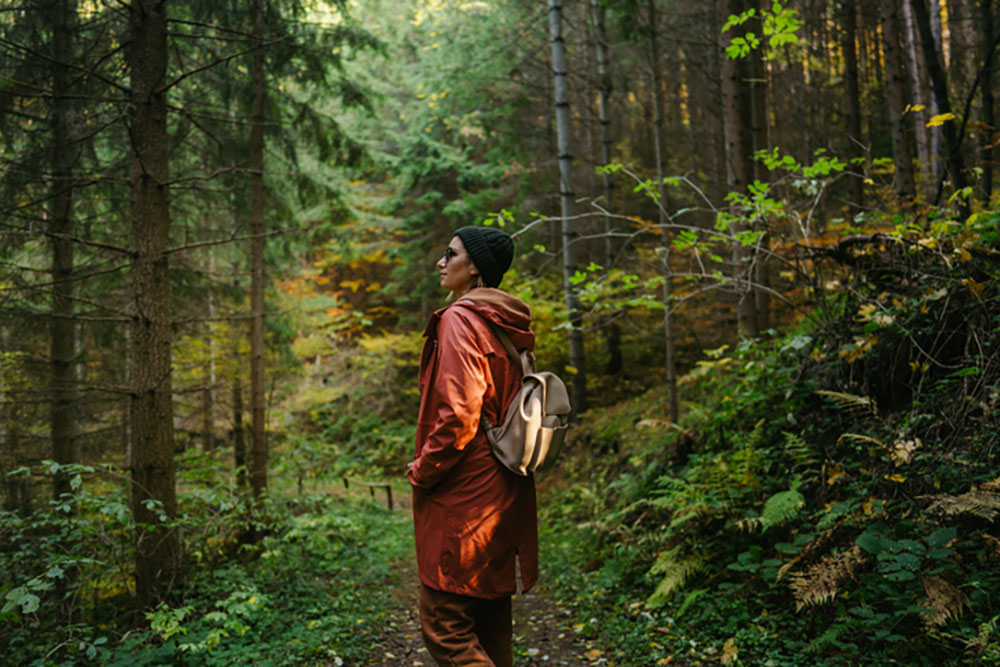
iStock
By Mary Carpenter
“Forest bathing” and “sound bathing” are activities with specific intentions and parameters. While skeptics question how they’re different from simply turning on music or walking among trees, both activities come with goals and guidelines, along with research supporting their benefits—hence, our two-part series.
Forest bathing—which originated in Japan as shinrin-yoku—led practitioners in one study to develop a “smaller self.” In selfies taken over an eight-week period, the heads of the forest bathers gradually became smaller in relation to their backgrounds—interpreted by the researchers as turning attention away from the self. As UCSF neurologist Virginia Sturm explained, while there is no science confirming what smaller heads accurately reflect, the group reported feeling happier, less upset, more socially connected than the control group —and showed a “small but significant improvement in well-being.”
All 52 volunteers in the study received directions to walk outdoors for 15 minutes weekly, taking selfies and writing online assessments to document their experiences. The group of forest bathers, who were also asked to walk in a new place when possible and pay attention to details “with fresh, childlike eyes,” became adept at “discovering and amplifying awe,” according to Sturm. The forest bathers paid less attention to themselves, while at least one person in the control group reported worrying about her to-do list.
“Awe—a positive emotion…in the presence of vast things not immediately understood—reduces self-focus [and] promotes social connection..by encouraging a “small self,” Sturm wrote in her original report titled “Big Smile, Small Self.” “Awe is partly about focusing on the world outside of your head”—and the study results suggest that cultivating awe diminishes “negative emotions that hasten decline [with aging].” The forest bathers also “displayed increasing smile intensity” over the course of the study.
Shinrin-yoku, or “taking in the forest atmosphere,” is a form of “ecotherapy” embraced by the Japanese beginning in the 1980s, writes Sunny Fitzgerald in National Geographic. Its two purposes: “to offer an eco-antidote to tech-boom burnout and to inspire residents to reconnect with and protect the country’s forests.”
Native evergreens in New York’s Adirondack Park are “both aromatic and release a high concentration of phytoncides—airborne essential oils that provide a natural immunity boost,” according to Fitzgerald, naming this park at the top of her list of five forest-bathing destinations. The phytoncide shower can last for weeks, while the needles of trees that include spruce and eastern hemlock can produce a tea “rich in antioxidants and Vitamin C.”
“Become more resilient” is the headline for a short AARP forest bathing recommendation: “20 minutes among the trees…exactly how much time you need in nature to reduce your level of stress hormones significantly.” A 2017 meta-analysis that included 40 interventional studies found “increased greenspace exposure associated with decreased salivary cortisol”—along with reduced incidence of stroke, asthma and coronary heart disease.
And, although not specifically forest bathing, 120 minutes spent on “recreational nature contact,” compared to no nature contact, led to a significantly higher “likelihood of reporting good health or high well-being,” according to a report in Nature. The seven-day study that included almost 20,000 participants in the “Monitor of Engagement with the Natural Environment Survey” between 2014 and 2016 found that “positive associations peaked between 200-300 minutes a week,” regardless of whether these took place over 28 to 42 minutes per day or one long visit with several shorter ones per week.
“The key [for forest bathing] is to practice mindfulness…focus on what your senses are taking in,” according to the KaiserPermanente website. To begin, “take a few deep breaths and center yourself… sit and watch how the trees sway in the wind or simply walk around… at a leisurely pace and without a specific destination in mind.”
For awe walks, look at your surroundings with fresh eyes or take a new walking path, advises the Kaiser site: “Remember to look for moments that make you feel amazement—or awe.” And pay attention to what your senses are taking in—whether it’s the scent of clean ocean air or a chorus of chirping birds.”
I take walks in the nearby forest but usually listening to music or accompanied by friends. On the few walks I have taken alone in silence, however, I have become aware of the changing light, the colors of leaves, the sounds of water rushing in the creek below. I am considering making a New Year’s resolution to plan more forest baths—or I might start more tentatively by wishing to try that, every now and then.
(Stay tuned next week for Sound Bathing.)
—Mary Carpenter regularly reports on need-to-know topics in health and medicine.

You inspire me to do the same!